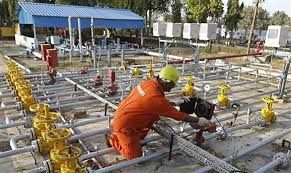 Given the efforts to move towards market-linked diesel prices and an expected decline in crude oil prices, underrecoveries on petroleum products are expected to drop to half those in 2013-14 through this financial year and the next, CRISIL has said in a report.
Given the efforts to move towards market-linked diesel prices and an expected decline in crude oil prices, underrecoveries on petroleum products are expected to drop to half those in 2013-14 through this financial year and the next, CRISIL has said in a report.
The report, ‘Road Ahead Clears Up for Oil PSUs’, says the decline in underrecoveries, or losses oil-marketing companies incur on selling petroleum products below market price, will have a significant positive impact on both upstream and downstream public-sector oil companies.
“PAT (profit after tax) of downstream companies will increase by Rs 3,300-3,600 crore (Rs 33-36 billion) on a year-on-year basis in 2014-15 and by another Rs 700-1,000 crore (Rs 7-10 billion) in 2015-16, as their interest cost will decline and they won’t have an underrecovery burden,” CRISIL has said.
“On the other hand, upstream companies, which typically share 40-50 per cent of the total underrecovery burden, will see a sharper Rs 10,500-12,000 crore (Rs 105-120 billion) year-on-year improvement in PAT in 2014-15 and a further improvement of Rs 7,000-7,500 crore (Rs 70-75 billion) in 2015-16.”
If the benefit from a potential rise in gas price to $8.4 a million British thermal units (mBtu) is taken into account, upstream companies’ PAT will further increase by Rs 7,000-7,500 crore (Rs 70-75 billion) in 2014-15, resulting in an overall increase of Rs 21,500-23,000 crore (Rs 215-230 billion), says the report.
In the past few years, high underrecoveries on sale of petroleum products have hit the financials of oil companies (both upstream and downstream).
This is because petroleum products like diesel, liquefied petroleum gas and kerosene are sold in India by downstream public-sector oil marketing companies at regulated prices, well below the cost (petrol prices were de-regulated in June 2010).
The resultant loss is usually shared by three parties -- the government, upstream oil companies (Oil and Natural Gas Corporation, Oil India Ltd and GAIL) and oil marketing companies (Indian Oil Corporation, Bharat Petroleum Corporation and Hindustan Petroleum Corporation) — in a proportion determined by the government every year.
Through the years, the sharp increase in overall underrecoveries and, consequently, the government’s
The interest cost has risen due to a significant rise in working capital requirements, owing to delay in payments from the government.
Over the years, the average delay in payments by the government has been three-six months; OMCs’ interest costs have more than tripled -- from Rs 3,000 crore (Rs 30 billion) in 2007-08 to Rs 10,400 crore (Rs 104 billion) in 2012-13, before declining to Rs 7,800 crore (Rs 78 billion) in 2013-14 (due to dollarisation of rupee loans and a decline in the underrecovery burden).
The total debt of these companies doubled from Rs 67,300 crore (Rs 673 billion) in 2007-08 to Rs 1,32,500 crore (Rs 1,325 billion) in 2013-14.
Since 2007-08, the short-term debt as a percentage of total debt has stood at an average 75 per cent, in line with the rising working capital requirement.
Due to conversion of rupee-denominated working capital loans to foreign long-term loans (external commercial borrowings of tenures of at least three years), the share of short-term debt declined in 2013-14.
The sharing of underrecoveries between the government and public-sector upstream and downstream companies is on an ad hoc basis, depending on the financial positions of these companies, as well as government finances.
In the past few years, with underrecoveries soaring from Rs 77,100 crore (Rs 771 billion) in 2007-08 to Rs 1,40,000 crore (Rs 1,400 billion) in 2013-14, the contribution of upstream companies towards underrecovery-sharing (in absolute terms) increased from Rs 25,700 crore (Rs 257 billion) in 2007-08 to Rs 67,000 crore (Rs 670 billion) in 2013-14.
As a result, these companies have not benefitted from the combined effect of high crude oil prices and a weak rupee.
Between 2008-09 and 2013-14, crude oil prices rose at a compound annual growth rate of five per cent to $108 a barrel.
During the same period, the rupee depreciated from 46 a dollar to 61 a dollar (six per cent CAGR).
However, upstream public-sector companies could not benefit from rising oil prices and a weak currency, as their net realisation declined from $48 a barrel in 2008-09 to $41 a barrel in 2013-14, owing to an increased share in underrecoveries.












 © 2025
© 2025